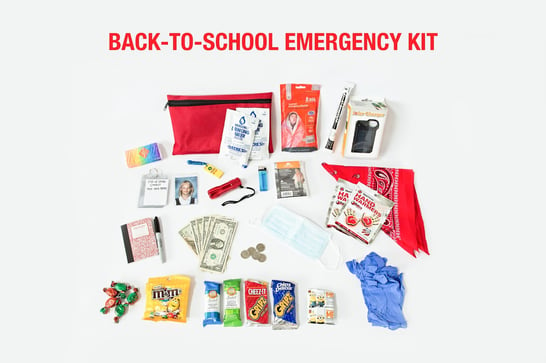2 min read
How To Build a Great Emergency Kit
![]() Bobby Decker, Operations Specialist
:
September 5, 2018
Bobby Decker, Operations Specialist
:
September 5, 2018

Your school's supply shed is filled with all of the emergency supplies needed to keep campus functioning for up to 72 hours following a disaster or emergency. Today, however, I want to talk about building smaller, individualized "go-kits" that are utilized not in lieu of that larger shed but in tandem with it. Having students build these kits at home is a great way to get your entire school community involved in school safety. First, let's jot down a list of what might go in one of these kits (Ziploc bag or other small container).
- Water (small pouches or bottle)
- Protein bar or granola snack
- Small flashlight
- Emergency whistles (strong and loud)
- Mini first aid kid (such as a few Band-Aids and antibiotic ointment)
- Emergency Blanket
- Hard candies for comfort and energy
- Comfort Item (small toy and/or picture etc.)
- Chapstick and Hand sanitizer
- ID with photo for emergency rescue workers to use
These go-kits have a dual utility. They obviously add to the emergency resources on campus, but they also can keep students calm and focused during a time of high-stress. Simply having the knowledge that their kit is there will serve as reassurance to students, as will the routine of going to get it before drills or in a legitimate emergency. A quick aside: most of these suggested supplies are targeted towards younger students. While it's still a good idea to have smaller go-kits for say, a high school, the personal "comfort" item is almost certainly a cell phone. Consider suggesting portable phone chargers as part of their kits. If there's no cell service, we'll cross that bridge when we come to it (and that bridge will be packed with surly teens).
Of course, storage space may be limited in classrooms, but a classroom cache of supplies in the case of an extended shelter-in-place or lockdown is another good form of preparation. In general, it's hard to go wrong with a stockpile of supplies, but here are some options of what might go into a medium-sized classroom kit or backpack.
- Clipboard with: class roster, list of students with unique needs (medical issues, prescription medication, dietary restrictions)
- List of school emergency procedures, including visual representation of best exit path from the classroom.
- Whistle and some form of teacher identification (hat, lanyard, vest)
- First aid kit with instructions
- Student activities (playing cards, board games, checkers, inflatable ball, etc.)
- Battery powered flashlight (extra batteries)
- Sanitary supplies
Proper preparation of emergency supplies and materials extends the amount of time your campus can sustain itself. As we've discussed, however, navigating an emergency takes more than just food and water. Effective emergency kits make everything better on the margins: mood improves, boredom is decreased, and distractions are minimized. Oh, and one last reminder. The faculty and staff on your campus are the greatest resource you have in an emergency. Make sure they're thinking about what they need to stay calm and effective, too. That means comfortable shoes, glasses, needed medications, and perhaps a comfort item of their own.

Unfortunately, that comfort item can't be red wine, but a good book can tide you over. Thanks for subscribing to our blog! Check out our resources page for more safety tips and tricks.

